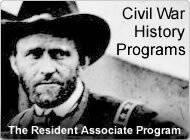
Seminar Review - Ten At Gettysburg, by Craig L. Symonds; Reviewed by Antigoni Ladd
The Smithsonian Associates Civil War E-Mail Newsletter, Volume 4, Number 8
Symonds opened by saying that history is not the product of culture alone, but may be driven by the decisions of strong individuals. Using that premise, he went on to examine ten individuals and the decisions they made that directly influenced the outcome at Gettysburg. Through this unique perspective, Symonds recounted the complex battle in a colorful fashion.
First on the list of ten has to be Robert E. Lee, commander of the Army of Northern Virginia. It was Lee's decision to invade Pennsylvania that started the machinations resulting in the epic 1863 battle.
From the Union side, Symonds' first pick was Joseph Hooker. Hooker's resignation after his failure at Chancellorsville two months earlier allowed Lincoln the opportunity to appoint George Gordon Meade to head the Army of the Potomac.
The story of Confederate general J.E.B. Stuart is more complex. True, he disappeared before the battle and did not provide Lee the military intelligence he depended upon. On the other hand, Symonds credits Stuart with screening Lee's movements north. He goes on to surmise that Stuart's bold ride around Federal forces wasn't just grandstanding, but rather an attempt to redeem himself for heavy southern losses at the cavalry engagement at Brandy Station the previous month.
Though killed on the first day of battle, Union I Corps commander John Reynolds played a key role. Reynolds rode to Gettysburg ahead of the infantry to assess the threat of the approaching Confederates. His decision to meet their columns and choose the field of battle at Gettysburg resulted in the subsequent Union stronghold at Cemetery Ridge.
Symonds then unraveled the rest of the story. He examined the actions of the commanders who, arriving in Gettysburg after the fighting began, moved into position and made critical decisions, many of them just in the "nick of time." Confederate Richard Ewell was a relatively inexperienced commander who had served under the stern Stonewall Jackson. Under Jackson, Ewell made no independent decisions. However, Jackson was dead and sorely missed and Ewell was now under Lee. Unlike Jackson, Lee gave general battle orders, expecting subordinates to respond as events unfolded. Unused to this style of command, Ewell did not respond as necessitated by events. Ewell then, is held accountable for NOT attacking Cemetery Hill on the first day--a missed opportunity for the outnumbered Confederates.
Federal commander Winfield Scott Hancock arrived the first day to find the Union army retreating through the streets of Gettysburg. Demonstrating boundless energy and uncanny tact , Hancock reorganized the forces into a position of strength on Cemetery Hill. James Longstreet, Lee's "Old War Horse" and commander of the First Corps, fundamentally agreed with Lee's vision, but disagreed with the tactics. On the third day, Longstreet faced the agony of carrying out the misnamed "Pickett's Charge," a decision with which he personally disagreed-a study unto itself in leadership decisions.
Unlike West Point graduate Longstreet, Union III Corps commander Daniel Sickles was not a professional soldier and did not always follow orders. Instead, this savvy politician and lawyer placed his men in a position which nearly cost them the Union line on Cemetery Hill. As a side note, if Sickles hadn't lost his leg that day and remade himself into a hero, he certainly would have lost his command and been cashiered out of the army.
A surprise addition to the list of Ten at Gettysburg was Symonds' selection of Edward Porter Alexander. Porter was a 28-year-old artillery commander who coordinated the artillery barrage, the prelude to Pickett's Charge. An interesting study in authority, Alexander might have prevented Pickett's Charge had he followed Longstreet's lead by telling Lee the infantry wasn't ready to proceed. The shrewd Alexander, knowing this was not his decision to make, remained silent. Instead, the infamous charge went forward, per Lee's orders.
Drawing the action to a close, Symonds examined the victorious, but underrated, George Gordon Meade. While the outcome of the three-day battle was a decisive victory for the Union, why didn't Meade attack Lee's retreating army? The reasons are complex: the troops were tired; the weather was poor; the Union commanders did not unite behind Meade; and Lee's troops had already moved to a strong defensive position on the Virginia riverbank.
Meade won the Battle of Gettysburg but lost an opportunity to end the war. Lee lost the Battle of Gettysburg but successfully escaped, enabling the Army of Northern Virginia to fight on for two more years. In spite of the many brilliant and the many disastrous decisions by strong leaders on both sides, Gettysburg should have marked the end of the war. Instead, it marked a bloody turning point.

Craig Symonds has been professor of history at the United States Naval Academy at Annapolis since 1976, where he was awarded both the Academy's Excellence in Teaching and Excellence in Research awards. He is author of eight books on the Civil War, four historical atlases, and several naval histories.

